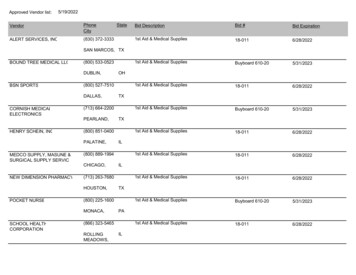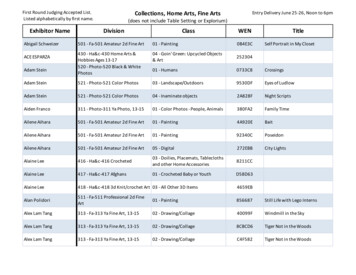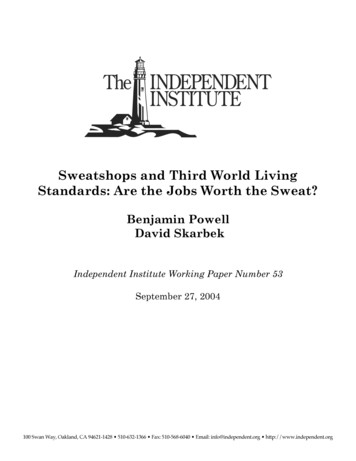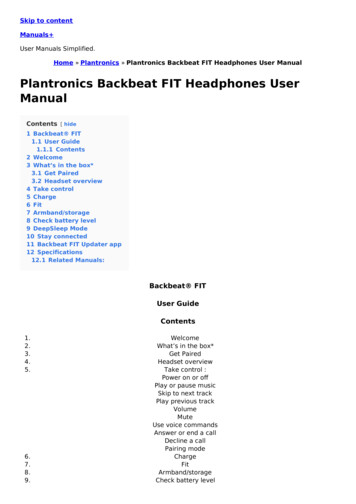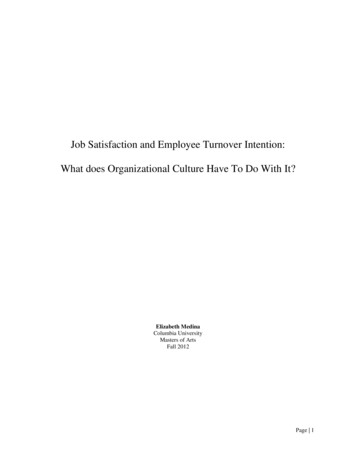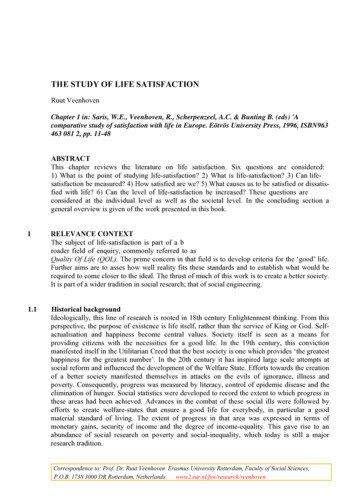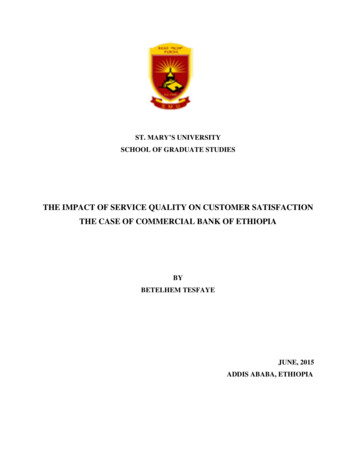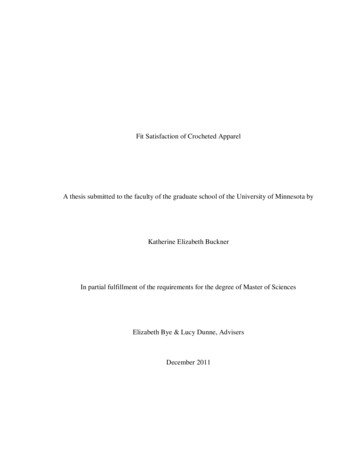
Transcription
Fit Satisfaction of Crocheted ApparelA thesis submitted to the faculty of the graduate school of the University of Minnesota byKatherine Elizabeth BucknerIn partial fulfillment of the requirements for the degree of Master of SciencesElizabeth Bye & Lucy Dunne, AdvisersDecember 2011
Copyright Katherine Elizabeth Buckner, 2011.
iACKNOWLEDGMENTSMany people contributed to making this project a success. I would like to thank mycommittee – Dr. Elizabeth Bye, Dr. Lucy Dunne, and Dr. Caroline Hayes – for theirflexibility, expertise, and support. Dr. Bye contributed her expertise in sizing and fitresearch to every stage of the process from planning to the final writing.At the 2011 Crochet Guild of America summer conference in Minneapolis, MN, Iinterviewed crochet designers (and teachers, authors, experts, bloggers they wear manyhats!) Edie Eckman, Darla Fanton, Marty Miller, and Karen Whooley. Edie and Martycontributed additional time to revising the questionnaire. Their willingness to make timeto contribute to this project was invaluable to the development of the Contextual Review,the questionnaire, and the final analysis.Sarah Kendall, Jen Cook, Pat Hemmis, and Erin McNellis helped with questionnaire pretesting. Laurie Wheeler and Deborah Burger provided permission and support forrecruitment and publicity of the questionnaire, as moderators of Ravelry crochet forums.Special thanks is also due to the participants themselves, who graciously volunteeredtheir time and opinions to add to the body of knowledge.Patrick Zimmerman of the University of Minnesota School of Statistics providedexcellent statistical consultation, and learned a lot about crochet in the process!My mother, Dr. Ginny Buckner, has taught me to value education and aspire to theacademic life. My grandmother, Mildred Paine, taught me to sew and spent many longhours cultivating a child‟s love of the creative process, from pasta art and sock dolls tocountless handmade garments, costumes, and charity projects.-KEB 12/2011
iiTABLE OF CONTENTSAcknowledgmentsiTable of ContentsiiList of TablesiiiList of FiguresivChapter 1: Introduction1Chapter 2: Contextual Review10Chapter 3: Methods44Chapter 4: Results54Chapter 5: Analysis and Conclusions72References86Appendix A: Questionnaire91
iiiList of Tables1. Summary of Age and Body Size Descriptors2. Participant-reported Experience Level in Garment-making by Category3. Class Experience4. Swatch Sizes: How large do you commonly make your swatch?5. Frequency of swatching, and washing and blocking swatch6. Common sources of garment patterns7. Current (Available) and Preferred (Unavailable) sources of help8. Frequency of avoiding a pattern due to fitting concerns9. Mean fit satisfaction by body area10. Garment type for last garment made11. Univariate analysis of variance – general subset12. Univariate analysis of variance – experience level subset13. Qualitative results55575860606162626464666770
ivList of Figures1. Crochet chain stitch2. Single crochet stitch (American terminology)3. Clothing comfort model4. Physical dimension triad5. Social-psychological dimension triad6. Stages of top-down sweater construction7. Two versions of the same garment made with different yarns8. Gauge swatches9. Example of pre-blocking sweater piece10. Example of sweater blocking11. Proposed funnel model12. Responses to “How many fitted garments have you crocheted for yourself?”13. Graphs of Behavioral Variables14. Ready-to-wear clothing fit satisfaction15. Ready-to-wear Fit Satisfaction & Overall Crocheted Apparel Fit Satisfaction16. Schematic of individual pieces17. Schematic of finished garment66151617233436383943565963687979
1CHAPTER 1 – INTRODUCTION“We who crochet clothing for ourselves and for others enjoy a very special and personalconnection to our craft. It is rewarding in so many ways to wear the items we make withour hands.” – Doris Chan (Interweave Crochet, Winter 2007, p. 42)Crochet designer Doris Chan sums up the appeal of the handcrafted garment, aunique artifact that stands at the intersection of the limited scholarly study of handcraftsand the evolving field of apparel research. Like ready-to-wear garments, crochetedclothing is subject to many levels of fit assessment, from the designer using a sizingstandard to determine how to create her pattern in multiple sizes, to the individualcrocheter trying on her finished sweater for the first time only to discover the sleevesreach her knees. Doris Chan goes on to say, “Unfortunately, not everything we crochetlooks good on us. Who hasn‟t suffered the heartbreak of finishing a gorgeous sweateronly to discover that it‟s unattractive on the body?” (Chan, 2007a, p. 42) Whendiscussing ready-to-wear clothing, Bougourd (2007) states “fit and comfort have beendescribed by consumers as synonymous with quality the final evaluation of the fitlies with the consumer, and there is a need to resolve consumer appearance and size andshape needs.” (p. 130)Crochet, knitting, and other handcrafts have enjoyed a surge in popularity inrecent years. The Craft and Hobby Association 2010 Attitudes & Usage Survey reportedthat the U.S. craft and hobby industry had 29.2 billion in sales in 2010, of which 1.062
2billion was specific to crochet. Their survey covered 114 million U.S. households andreported that 17.4 million reported that they had engaged in crocheting in the last year,ranking it third among the crafts and hobbies profiled in the survey, and above otherneedle crafts such as knitting and cross-stitch (Craft and Hobby Association, 2011).The National Needle Arts Association (TNNA), which is a more exclusive, tradeassociation focusing on the “specialty needlearts” (knitting, crochet, needlepoint,embroidery, spinning, and weaving), reported on crochet in their 2010 State of SpecialtyNeedle Arts. From studying over 10,000 “needlearts consumers sourced from needleartsmagazines, Web sites, and specialty retailers,” they report that the specialty crochetmarket consists of 464,000 people who spent 264 million on supplies in 2009. However,it is important to note that this survey categorized knitters and crocheters separately, and42% of the “knitting” respondents – a larger category with a market size of 780,000 andspending of 629 million – completed at least one crochet project.A Craft Yarn Council of America (CYCA) study (2004) reports that interest inknitting and crochet increased 150 percent between 2002 and 2004 among women ages25 to 34, with increases among other age groups as well. Counteracting the stereotype oftextile handcrafts as the domain of women of earlier, now older, generations, “knowledgeis passing laterally within one generation as friend teaches friend” (Swartz, 2002, p. 1)and crochet and knitting books and publications aim to appeal to a younger market intheir choice of graphic design, clothing styles, and language (Chan, 2007b; Lee, 2006;Stoller, 2006).
3The Internet has provided crocheters and other needleartists and crafters arevolutionary opportunity to interact with others who share their interests, form onlinecommunities, exchange information, and buy and sell materials and completed projects.One of the largest needlearts sites, Ravelry, was started in 2007 by Casey and Jess Forbes(Humphreys, 2009). It offers knitters and crocheters, as well as spinners and dyers, aplace to keep track of projects and stored materials (one‟s “stash” of yarn), connect withother crafters via public forums and self-organized groups, and buy and sell patterns andproducts. As a specialist social-networking site, it has enjoyed great success. As ofNovember 2011, there are 1.7 million registered users, and the site is used in a variety ofways for organization, social networking, problem-solving, and business transactions.As of November 2011, there were 67,410 crochet patterns listed on Ravelry, ofwhich 8,139 are clothing patterns, and 3,921 of those are categorized as “adult female.”Ravelry‟s pattern categorization is entirely user-run, and some errors may exist, but thesenumbers should serve as current working estimates for widely available crochet clothingpatterns. In addition, there are garments made by individuals who are not working from apublished pattern, and some fraction of patterns not listed on Ravelry. Medford (2006)refers to knitting patterns as the “scripts by which knitters create and customize theirgarments,” (p. 1) which provides one lens for looking at the purpose of patterns forhandcrafted textile artifacts.On the other hand, the crochet community is regarded as coming more slowly tothe idea of making fitted garments than the knitting community, although the interest isthere. “By far the largest segment of the crochet population comes from a place of craft
4yarn and from making not-garments” (Chan, 2011). Chan suggests that the Craft andHobby Association Attitude and Usage Survey and the National Needle Arts Association2010 survey back up the “traditional and stereotypic inference” that crocheters, as apopulation, focus more on home goods and décor items, and knitters focus more ongarments. Designers and the TNNA survey both report that there is demand fromcrocheters for more garment patterns (E. Eckman, personal communication, July 30,2011; TNNA, 2010) and the CYCA reports that there was a 40% increase in the numberof knitters and crocheters making sweaters and vests between 2005 and 2007 (CYCA,2008). Although the CYCA study covers both knitters and crocheters, the majority ofparticipants reported that they both knit and crochet, or crochet only.Blood (2006) used the term “non-industrial textile production” to mean “activitiesthat involve the manual design and creation of textile items that are not mass-producedsuch as via commercial assembly line methods.” (p. 50) Blood‟s study included manyother activities besides crochet under this umbrella term, and included many finishedtextile items besides garments, but the term is nonetheless useful in contrasting“handmade items” or “handcrafting hobbies” from ready-to-wear garments and massproduction of apparel and textile products. Johnson and Wilson (2005) define “textilehandcraft” as “artifacts that have been individually produced (as opposed to massproduced) using implements such as sewing needles, crochet hook, or knitting needles,and completed as lapwork.” (p. 115)
5What is Crochet?Knitting and crochet have much in common, but there are many differencesbetween the two crafts. Knitting is “the process of forming a fabric by makinginterlocking loops from a continuous strand of yarn using two or more needles.”(“Basic,” 2002, p. 22) The simplest form of knitting is traditionally done using twoneedles. Stitches are formed by holding stitches on one needle, inserting the other needleinto each stitch, wrapping and working the yarn through the loops of the stitch, andtransferring the resulting new stitch to the other needle. Crochet, which is defined byMerriam-Webster‟s Dictionary as “needlework consisting of the interlocking of loopedstitches formed with a single thread and a hooked needle,” is typically started by creatinga series of loops, or chain stitches, by pulling a hook through the preceding loop afterwrapping the yarn around the hook.Figure 1 and Figure 2 show the process of making a chain stitch and a simplecrochet stitch, the single crochet1. Taller stitches such as double and treble crochet can beformed by wrapping the yarn around the hook one or more times before pulling through.“The unwritten rules of crochet and knitting dictate that knitting, with itsinterlocking loops of a single thickness, creates the thinnest, most flexible fabricpossible from looping a strand of yarn. Crochet, on the other hand, with itsmultiple loops drawn through each other to form a basic stitch, produces aheavier, denser, and more stable fabric.” (Dayne, 2007, p. 22)1Note: American crochet terminology will be used throughout this research. In the United Kingdom andelsewhere, other terminology is used to refer to the same stitches, which can lead to confusion. Whenreading a crochet pattern, it is critical to understand which regional terminology is in use.
6Fig. 1: Forming a chain stitch, commonly used as a foundation on which to add otherstitches and form a crocheted fabric. (Source: tructions10.htm)Fig. 2: Forming a fabric from single crochet stitches. This shows two rows of existingstitches and the formation of a new stitch using the hook and working yarn. (Source:TLC)
7This structural difference is one reason why crochet garment construction isworthy of analysis. “ in many ways we‟re experiencing a new era of the craft. The vastmajority of crocheted garments used to be unsophisticated. They were stiff, heavy, bulky,and boxy. To say they were unflattering would be an understatement. Because of this,crocheters have not paid a huge amount of attention to garment construction relative to,say, sewers and knitters.” (Werker, 2006, p. 104)The timeline of the history of crochet includes speculation about how it got itsstart, including references to other fiber arts such as knitting and macramé. Mostchronologies agree that the modern history of crochet begins in the 1800s, when it wasused in Europe to make lace. The availability of printed patterns led women in Europeand the United States to make household items both commercially and at home during the1800s and early 1900s (Ohrenstein, 2009). The craft suffered during World War II due tomaterial shortages and rationing, and experienced a resurgence in the 1970s when itbecame popular for both home items and clothing (Stoller, 2006; Stanziano, 2002).Sources imply that the popularity was not maintained after that decade, though, and themodern interest in the craft is part of a broader interest in handcrafts and a “DIY”mentality, including the involvement of a younger generation of crafters who crochet as ahobby rather than a necessity.In terms of fashion, the modern revival of crochet is considered a “new era” ascompared to the 1970s styles, and it is common to hear crocheters lament that “peopleassume that decent fashionable garments can‟t be done in crochet” (Merrick, quoted inBlakley Kinsler, 2008, p. 35). It is true that crocheting with equivalent materials will
8yield a fabric that is denser and with less stretch than knitting, which means it works wellfor structured or solid items like afghans and stuffed toys (Stoller, 2006). Between thisstructural assumption (especially when compared to knitted fabric) and crochet‟s historyas a technique for making decorative lace such as doilies, the development ofcommercially and widely available crocheted garment patterns is still very much a workin progress.Research Questions and Summary of JustificationThe research questions for this study were developed from personal experiencewith handmade clothing and handcrafts, including a longstanding interest in and practiceof sewing and crochet. Over the last decade, the increased popularity of the Internet hasprovided an opportunity for online communities to form to connect individuals withsimilar interests on an unprecedented scale. My experiences with crochet patterns andprojects, as well as the experiences reported online by other crocheters on websites suchas Ravelry, suggest that research on this topic would be timely and valuable.Fit satisfaction issues in ready-to-wear garments have been documented in apparelresearch. Individual body variations coupled with the lack of standardization of sizingsystems in the apparel industry can lead to widespread consumer dissatisfaction with thefit of ready-to-wear items. While handmade garments offer the individual an opportunityto customize the garment as it is made, a variety of issues such as sizing systems, sizeselection, and individual level of expertise may negate some of this theoretical benefit.
9Little research has been conducted on topics related to handcrafted clothing,particularly in the context of sizing. In theory, handcrafted garments offer the wearer anopportunity to customize the garment to fit her own measurements. The purpose of thisstudy was to examine fit satisfaction and possible contributing variables among womenwho crochet clothing for themselves. The study was guided by the following objectives:1. Identify fit satisfaction and dissatisfaction among garment crocheters2. Identify crocheter background variables that may affect fit and fitsatisfaction, such as experience level and knowledge of related fields3. Identify crocheter behavior that affects fit, such as garment constructionand finishing techniques4. Seek feedback from crocheters as to their opinions of the sources of fitsatisfaction and dissatisfaction and how to improve situations in whichdissatisfaction does exist5. Analyze reported behavior and feedback to suggest exploratory theoriesand hypotheses that can provide a basis for future research
10CHAPTER 2 – CONTEXTUAL REVIEWThe following review contains topics related to the concept of fit satisfaction tothe modern crocheter and her experience with crafting her own garments. First, thehistory of fit satisfaction research concerning ready-to-wear apparel will be discussed toprovide background on the concepts of fit and fit satisfaction, and the underlying factorsthat contribute to an individual's assessment of how her clothing fits. Next, research aboutnon-industrial textile production techniques such as home sewing and handcrafts will bediscussed to situate the current study and justify the importance of studying the topic.Finally, a review of crochet resources and interviews with designers will providebackground on sizing and fit in the crochet industry.Fit Satisfaction Issues in Ready-to-wearGarment fit contributes significantly to psychological and social well-being(Smathers and Horridge, 1978-79). Fit has been defined as “a correspondence in threedimensional form and in placement of detail between the figure and its covering to suitthe purpose of the garment, to provide for activity, and to fulfill the intended style.”(Berry, 1963, p. 314). The relationship of the garment to the body involves multiplefactors including the individual‟s overall body size, body proportions, and the garment‟sdimension and drape. Problems in this domain can occur when garments are made withdeficiencies in pattern development, grading, sizing, or construction; thus, quality of fitwill be improved with the appropriate development and implementation of effective
11patternmaking techniques and proper sizing and grading systems (Sohn, 2009). Gradingis defined as “the process used by clothing manufacturers to produce patterns for agarment in a range of sizes for ready-to-wear clothing.” (Schofield, 2007, p. 152)The concept of “fit” comprises an objective measure of fit as well as theperception of the fit as analyzed by both experts and subjects (wearers) (Ashdown, 2000).Fit satisfaction will depend on subjective individual fit preference and the extent to whichthe garment correlates with the wearer‟s expectations (LaBat, Salusso, & Rhee, 2007). Fitpreference is affected by many factors, such as body cathexis, personal comfortpreferences, and social messages (LaBat, 1987).It has previously been established that issues with fit satisfaction exist in ready-towear garments (LaBat, 1987; Ashdown, 1991; Alexander, Connell, & Presley, 2000). Theapparel industry must work with the “inherent contradictions of providing well-fittingclothing within the constraints of economical and practical sizing systems for the varietyof people in a population.” (Ashdown, 2007, p. xvii) There is not a consistent sizingstandard in ready-to-wear clothing, and this combined with differences between theassumptions made by sizing systems and the actual body sizes of the population leads towidespread fit dissatisfaction (Petrova, 2007).According to Halstead (1989), consumer satisfaction with a product is based onthe expectancy disconfirmation model. The individual‟s satisfaction with the product isbased on the extent and direction of disconfirmation beliefs, which results from “thecustomer‟s comparison of product expectations and perceived product performance.”
12Expectations can be set based on the sizing system as well as the visual expectation ofhow the garment will look on the body based on viewing it on a rack or mannequin. Inthe case of crocheted clothing made from patterns, there is a parallel experience when thecrocheter looks at the photograph of the sample garment that accompanies the pattern.Bye and DeLong (1994) found that the visual effect of a garment design is notmaintained across the size range using standard methods of apparel grading. Anotherelement of fit satisfaction is comfort, as outlined by Ashdown (1991). These two facets –comfort and appearance – are one way of understanding the components of fitsatisfaction.LaBat (1987) recruited 107 female apparel students between the ages of 19 and 40for a study about consumer satisfaction with ready-to-wear clothing fit. The participantswere asked to respond to specific statements about fit by rating their response on 5-pointLikert scales. The responses indicated that dissatisfaction with fit does exist. LaBatchiefly analyzed body cathexis as a contributing factor, defined as “degree of satisfactionor dissatisfaction with various parts or processes of the body” (Secord and Jourard, 1953,p. 343). LaBat analyzed the relationship between body cathexis and fit satisfaction,noting that women often blame their own bodies for poor garment fit, based on anunrealistic interpretation of the sizing system. This can lead to negative body cathexis andbody image in turn. Women reported lower satisfaction with the fit of clothing atparticular body sites when they also felt dissatisfied with those parts of their body (LaBatand DeLong, 1990).Clothing Comfort Theories
13Clothing comfort was examined by Branson and Sweeney (1994), who conducteda review of existing models before proposing their own. “Clothing comfort appears to bean extremely complex phenomenon resulting from the interactions of various physicaland non-physical stimuli for a person wearing a given ensemble under givenenvironmental conditions.” (p. 94) Sontag (1985) defined “human comfort” as “a mentalstate of ease of well-being, a state of balance or equilibrium that exists between a personand the environment.” She used a human ecosystems approach and placed variables thataffect comfort in one of three concentric circles: person attributes, such as expectations,experience, and physical factors like height and weight; clothing attributes, such as theconstruction and style of the garment, and environmental attributes such as climate andhabitat as well as social factors. Sontag defined three dimensions of comfort with respectto clothing: physical, psychological, and social. Physical comfort involves “satisfactionwith the physical attributes of a garment,” psychological comfort is concerned with“satisfaction with desired affective states,” and social comfort is defined as “a mentalstate of social well-being expressive of the appropriateness of one's clothing to theoccasion, satisfaction with the impression conveyed to others, or with the degree ofdesired conformity to the dress of one's peers.” (p. 98)The analysis of Sontag's model by Branson and Sweeney states that “empiricaldata did not support a clear distinction between psychological and social comfort.”Satisfaction with the appearance of the garment can be considered to fall underpsychological and social comfort, particularly the elements defined as part of socialcomfort: appropriateness, impression, and conformity.
14Branson and Sweeney then defined their own model of clothing comfort. Theyemphasize that it is a model in the Gestalt tradition, and “each part influences and in turnis influenced by every other part.” (p. 100) The elements of their model are the physicaldimension triad, the social-psychological dimension triad, the physiological/perceptualresponse, the filter, and finally the clothing comfort judgment. (Figure 3) “Triad” refersto person, clothing, and environment, as in Sontag's model. The physical dimension triadincludes elements of each of the three parts that relate to the physical dimension, such asphysical attributes of the person, of the garment (which includes the fit), and theenvironment. The social-psychological dimension triad includes attributes of the personsuch as body cathexis, values, and attitudes; attributes of the clothing such as aesthetics,fashionability, and design; and attributes of the environment such as the occasion, thepresence of particular people, and social norms. The physiological/perceptual responsepart of the model refers to “responses elicited [by] the interaction of some set of thephysical and social attributes of the triad in a given context,” (p. 103) such as bodytemperature (physiological) or thermal comfort (perceptual). The filter is “the merging ofinputs.for a unique individual wearing a given ensemble in a given context to make aunique determination of clothing comfort.” (p. 104) All these elements work together tocreate the individual's judgment of comfort of the clothing they are wearing.
15Figure 3. Clothing comfort model. From “Conceptualization and measurement ofclothing comfort: Toward a metatheory,” by D.H. Branson and M. Sweeney, 1991.Branson and Sweeney list “fit” as an element of the “Clothing System” under“Clothing Attributes” of the physical dimension. (Figure 4) In this case, I believe they arereferring to the definition of fit as the physical relationship of the garment to the body,without including social-psychological elements such as individual fit preference. Thesecomponents are covered in the “Person Attributes” of the social-psychological dimension(Figure 5), though they are not explicitly listed there in Branson and Sweeney's model.
16Figure 4. Physical dimension triad. From “Conceptualization and measurement ofclothing comfort: Toward a metatheory,” by D.H. Branson and M. Sweeney, 1991.I noted the placement of “Aesthetics” of the clothing as part of the “Fabric andClothing System” under “Clothing Attributes” in the social-psychological dimension ofBranson and Sweeney's model. This mirrors the presence of “Fit” under the samecategory in the physical dimension triad. Branson and Sweeney emphasize theinterrelatedness of all parts of their model, so when focusing on fit, it can be theorizedthat the physical and social-psychological dimensions work together in the combinationof physical comfort and aesthetic judgment that lead to an overall judgment of fitsatisfaction.The first three sections of the clothing comfort model were previously used byChattaraman and Rudd (2006) in their study of preferences for the aesthetic attributes of
17clothing in terms of body cathexis and body size. Body cathexis is a social-psychologicalperson attribute and body size is a physical person attribute on Branson and Sweeney'smodel, so the Chattaraman and Rudd study focused on the interaction between attributesbetween triads. The authors found a relationship between body image and body cathexisand preferences for aesthetic attributes – for example, “lower body image correlates withpreference for greater body coverage and less revealing silhouettes in clothing and viceversa” (p. 58). The authors also state that their study shows that “both physical andsocial-psychological attributes relating to the body interact with clothing attributes toproduce a perceptual response.” (p. 58)Figure 5. Social-psychological dimension triad. From “Conceptualization andmeasurement of clothing comfort: Toward a metatheory,” by D.H. Branson and M.Sweeney, 1991.
18In summary, fit satisfaction of ready-to-wear garments has been studiedextensively, and researchers have broken down different elements and sources ofsatisfaction and dissatisfaction, categorizing them into physical and social-psychologicalelements. “Perception of fit as judged by the wearer involves several major issues,namely appearance or how the wearer perceives that the garment looks on themselves,and perception of comfort based on both tactile and visual responses.” (Branson & Nam,2007, p. 272) Next, an analysis of research on non-industrial textile production andhandcrafts will provide background on this aspect of the current research.Non-Industrial Textile ProductionBlood (2006) defines “non-industrial textile production” as “activities that involvethe manual design and creation of textile items that are not mass-produced such as viacommercial assembly line methods.” (p. 50) According to Blood and other researchers,generalizations can be made between these activities, often considered “hobbies” incontemporary society, in terms of their goals, products, and motivations. Although thepresent study is specific to crochet, reviewing literature on related topics such as homesewing and knitting, specifically those that also result in the production of garments, willaid in an understanding of the background to this study.Schofield-Tomschin (1999) conducted a literature review of motivations for homesewing, which included a desire for higher quality, better-fitting garments than what wascommercially available, economic motivations, and a desire to express oneself creatively
19and obtain psychological benefits through the process. Cerny, Eicher and DeLong (1993)found that quilt guild participants sought to “gain a sense of social self and satisfy leisureand educational needs.” Heglend and Hemmis (1994) found that for a commercialknitwear designer, the process of mastering knitting techniques and skills wasintrinsically pleasurable, and she derived a “deep sense of personal satisfaction andaccomplishment” from those processes. It is clear that the process of participating in nonindustrial textile
Knitting and crochet have much in common, but there are many differences between the two crafts. Knitting is “the process of forming a fabric by making interlocking loops from a continuous strand of yarn using two or more needles.” (“Basic,” 2002, p. 22) The simplest form of k
